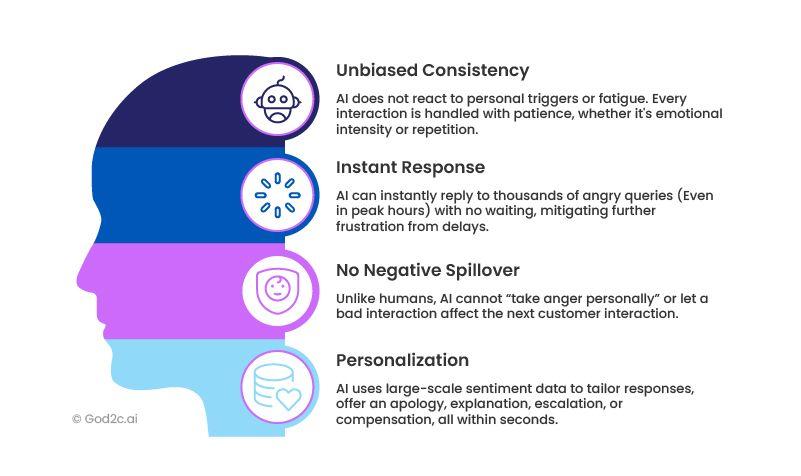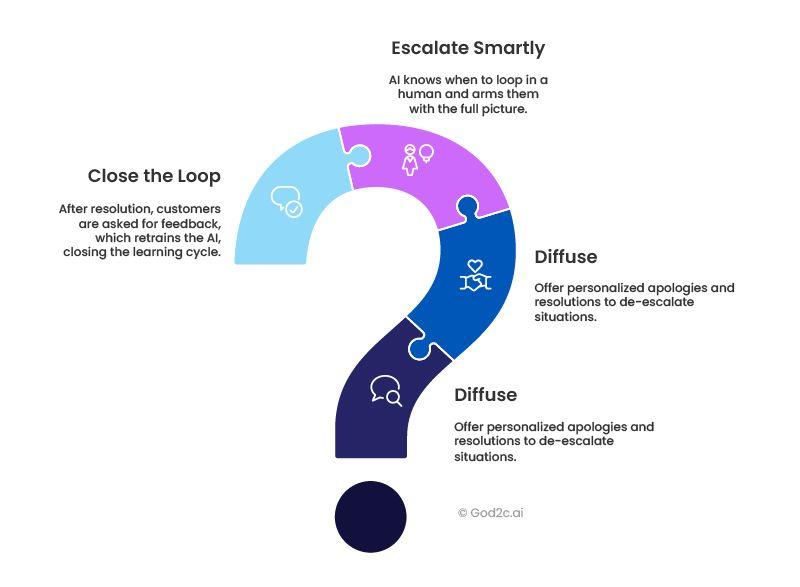How AI Handles Angry Customers Better Than Humans
With over 800 active brands in the Indian D2C market, the market value is expected to exceed $100 billion by the end of this year. In this high-stakes D2C landscape, every angry customer represents both a risk and an opportunity. Competition is fierce, and businesses face several challenges, such as digitally savvy customers who are quick to share negative experiences online and expect quick resolutions in their preferred language. Handling upset customers is critical for any D2C brand.
In India, customer demands in the D2C sector are complex and socially nuanced. Traditional call centres often struggle with fatigue, emotional contagion, or language barriers that can unintentionally escalate situations. This is where AI, designed for precision and empathy at scale, clearly outperforms human-only models. AI-powered support platforms (like GoD2C.ai) offer transformative advantages in de-escalating, understanding, and resolving customer anger, while also boosting customer engagement through AI-driven personalization.
Why AI Excels at Handling Angry Customers
- Unbiased Consistency: AI does not react to personal triggers or fatigue. Every interaction is handled with patience, whetherit'semotional intensity or repetition.
- Instant Response: AI can instantly reply to thousands of angry queries (Even inpeak hours) with no waiting, mitigating further frustration from delays.
- No Negative Spillover: Unlike humans, AI cannot “take anger personally” or let a bad interaction affect the next customer interaction.
- Personalization: AI uses large-scale sentiment data to tailor responses, offer an apology, explanation, escalation, or compensation, all within seconds.

AI’s Unique Advantages for Indian D2C Brands
For India’s vibrant, complex D2C landscape, AI brings unique strengths that address the country’s linguistic and cultural diversity:
- Unwavering Patience and Emotional Neutrality: AI is always emotionally neutral, never reacting defensively or showing bias, essential where communication styles are highly diverse and direct confrontation may be culturally sensitive. Its 24/7 availability is vital for servicing customers across multiple time zones and during high-traffic periods, reducing anger fueled by delays.
- Rapid Data Processing & Hyper-Local Sentiment Analysis: AI analyses multi-language inputs (like Hinglish or Tamil-English blends), detecting frustration and urgency in real time. It uses behavioural and historical data to spot potential customer issues before they escalate, enabling proactive support and mitigation.
- Consistent and Accurate Multilingual Information: AI accesses comprehensive, up-to-date knowledge bases to deliver uniform and accurate solutions in any language, eliminating confusion from inconsistent agent responses and building brand trust.
- Intelligent Routing and Seamless Escalation: For complex or highly emotional cases, AI routes queries transparently to the most suitable human agentby language, region, or expertise, and provides a complete interaction history, so the customer never needs to repeat themselves.
- Scalability and Cost-Effectiveness: AI can handle massive inquiry volumes during sales peaks like Diwali without proportionately increasing costs. It allows D2C brands to maintain quality as they scale, reducing service costs by up to 30% and letting human agents focus on nuanced or high-value cases.
How AI Detects, Decodes, and De-escalatesAnger
1. Anger Detection
AI systems use advanced Natural Language Processing (NLP) models trained on millions of local support transcripts. This enables:
- Instant Emotional Recognition: AI identifies signals of frustration, sarcasm, or escalation from the very first word, across languages, code-mixed text, and even emoji or punctuation patterns.
- Depth Over Keywords: Instead of reacting to just “angry words,” AI analyses sentence structure, repetition, tone shifts in voice calls, and response speed for underlying emotional trends.
2. De-escalation
Unlike scripted bots or variable human reactions, AI brings in:
- Empathy-First Approach: The system acknowledges and names the angerbefore anything else.
- Transparency: Customers are immediately told what will happen, without hedging, jargon, or delay.
- Adaptive Tone: Modifies friendliness, formality, and clarity to suit customer profile, prior history, and context.
3. AI-Human Magic
Crucially, when a case escalates, AI orchestrates a clean handover:
- Full Emotional Context Transfer: Human agents receive a summary of the customer’s mood, recent messages, urgency rating, and prior actions, not just the ticket number.
- Live Sentiment Updates: If the customer’s anger spikes, agents get real-time prompts on tone or urgency adjustments.
Core AI Capabilities Driving Effective De-escalation
- AI-Powered Chatbots and Virtual Assistants: These often serve as the first point of contact. They deliver immediate, consistent answers to common questions, guide customers through troubleshooting, and can effectively defuse initial frustration by providing quick solutions to simple issues. For example, chatbots can handle inquiries about order tracking or basic product information, preventing minor irritations from escalating.
- Sentiment Analysis and Emotion Detection Tools: These tools act as the "ears" and "eyes" of AI in customer service. By monitoring customer language and vocal cues in real-time, they can identify growing anger. This prompts alerts for human agents and may even suggest empathetic responses.
- Natural Language Processing (NLP): NLP allows AI to grasp the subtleties of human language, including sarcasm, idioms, and colloquialisms, which are often misunderstood by humans. This deeper contextual understanding enables AI to handle complex queries more effectively and produce relevant, human-like responses.
- Real-time Agent Assist Tools: These are valuable tools for human agents. Often called "whisper agents," they offer live guidance and suggestions during calls, such as empathetic phrases, solution-focused responses, or relevant information from the knowledge base. "Battlecards" can provide context-aware information and solutions, empowering agents to confidently handle challenging conversations and enhance their performance.
Proven ProcessThat Delivers Measurable Results
- Listen First, Fast: AI analyses and acknowledges emotional signals within seconds, across WhatsApp, IVR, chat, or email.
- Diffuse: Quick, personalized apology or explanation, plus clear resolution offers, no generic “we’re sorry.”
- Escalate Smartly: AI knows when to loop in a human and arms them with the full picture.
- Close the Loop: After resolution, customers are asked for feedback, which retrains the AI, closing the learning cycle.

Real-world Examples
Here are a few use cases of Indian D2C brands leveraging AI for anger management and sentiment-driven customer service:
1. Leading D2C E-commerce Brand (via SparkTG)
A popular Indian D2C e-commerce brand integrated SparkTG’s AI-powered chatbot to automate support interactions and sentiment response. Highlights:
- Instant Query Resolution & 24/7 Support: Customers received immediate answers to order and complaint queries without human intervention, reducing frustration from long wait times.
- AI-Based Sentiment Analysis: The system detected customer complaints and anger in real time, alerting staff or triggering escalation whenever negative sentiment was perceived.
- Results: Enabled timely reactions to angry contacts, leading to increased customer satisfaction and loyalty; observed a marked rise in repeat engagement and overall retention rates for the brand.
2. Pondicherri.Life (The Pant Project) – D2C Retail
The Pant Project, a D2C apparel brand in India, systematically tackled customer anger and escalation by:
- First Touch Solutions: Their team used AI-powered systems to maximize issue resolutions at the initial point of contact, reducing the escalation “bounce” that typically amplifies customer anger.
- Empathy and Education: While AI supported escalation tracking, their team trained both AI helpers and humans to empathize with customer frustration and educate customers about delays or policies, which directly reduced negative interactions
Conclusion
AI's strengths in de-escalation, its unwavering patience, rapid analysis, consistent information delivery, and efficient routing make it an essential tool in managing angry customer interactions. However, AI is not a replacement for human agents; it's a powerful enabler. The future of customer service for D2C brands in India lies in a synergistic partnership where AI empowers human teams to deliver a more efficient, consistent, and ultimately more empathetic experience. By combining the best of both worlds, D2C brands can turn frustration into satisfaction and build stronger, more loyal customer relationships.
Ready to transform your support with God2C.in?
GOD2C.in is designed for India’s D2C ecosystem to help businesses with an AI-enabled customer engagement platform that also offers multilingual support with robust data security. No more unhappy customers, instead connect with precision 24/7, across every channel.
References:
https://metricscart.com/insights/improving-customer-experience-with-sentiment-analysis/
https://sparktg.com/case-study/enhancing-customer-service-with-ai-d2c-success.html

